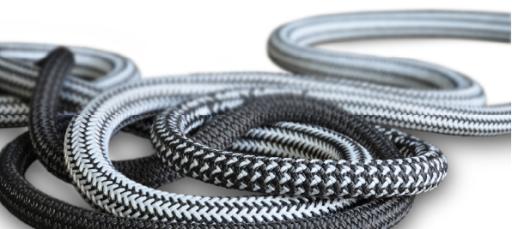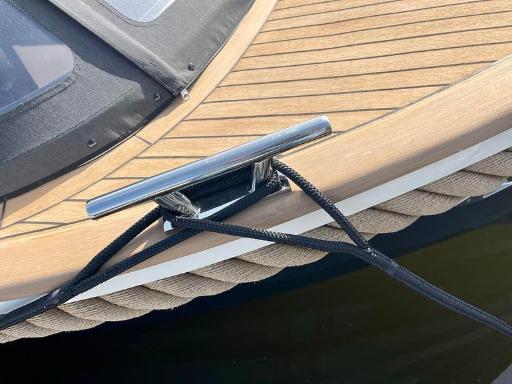The foundation of a safe and comfortable mooring
Choosing the right mooring ropes is one of the most important yet often overlooked aspects of yacht handling. Your mooring ropes are what connect your yacht to the dock — absorbing every gust, surge, and wake that hits your hull.
The key is to select ropes that combine the right strength, stretch, and durability for your yacht’s displacement and the conditions you moor in. Rope construction and material choice directly affect performance, longevity, and comfort aboard.
Matching mooring rope diameter to yacht size
Rope diameter scales with vessel displacement and load. A mooring rope that’s too thin risks fatigue or failure; one that’s too thick becomes too stiff to absorb shock loads effectively.
For most cruising monohulls, the following is a reliable guide:
|
Yacht Length |
Typical Rope Ø |
Recommended Line Type |
|
Up to 25 ft (7.5 m) |
8–10 mm |
Double Braid Polyester |
|
25–35 ft (10.5 m) |
10–12 mm |
Double Braid Polyester |
|
35–45 ft (13.5 m) |
12–16 mm |
Double Braid Polyester |
|
45–55 ft (16.5 m) |
14–18 mm |
Double Braid Polyester |
|
55 ft+ |
18–24 mm |
Double Braid Polyester or Dyneema® blend |
These sizes assume typical displacement cruising yachts. Lightweight racers can scale slightly down, while heavy-displacement or liveaboard yachts should scale up for greater security.
Gottifredi Maffioli Double Braid Mooring Ropes
Mooring rope material makes the real difference
Different mooring rope materials behave very differently under load. Their stretch, strength, and UV resistance define how they handle shock loads, weathering, and long-term use.
|
Material |
Stretch |
Strength |
UV / Abrasion |
Typical Use |
|
Nylon (Polyamide) |
High (up to 20%) |
Moderate |
Good |
High stretch – effective shock absorption but less UV stability over time |
|
Polyester (PET) |
Medium (6–10%) |
High |
Excellent |
The standard for most sailing yachts – strong, durable, low-maintenance |
|
Polypropylene |
Medium (10–15%) |
Low |
Fair |
Lightweight and floats – best for temporary or secondary lines |
|
HMPE / Dyneema® |
Very low (<2%) |
Very high |
Excellent |
Premium option for high-load applications or superyachts |
For the vast majority of sailors, Double Braid Polyester mooring ropes are the best choice.
They’re tough, UV-resistant, and hold up for years in sun and salt. They offer moderate elasticity for shock absorption, remain supple for easy handling, and run smoothly through fairleads and cleats.
For larger or performance yachts, Dyneema®-cored mooring ropes combine exceptional strength and abrasion resistance with minimal creep. However, since Dyneema® has almost no natural stretch, it’s important to include a mooring compensator to absorb shocks and protect deck fittings.
Upffront recommendation:
For cruising yachts from 30–55 ft, Double Braid Polyester is the ideal all-round mooring rope — strong, smooth-handling, and long-lasting. For performance or heavy yachts, upgrade to Dyneema®-cored ropes paired with a compensator for the ultimate in strength and control.
How rope elasticity affects mooring comfort
The amount of stretch in your mooring ropes determines how well your yacht rides out gusts, tide, and wash:
- Too little stretch → sharp loads, noise, and hardware fatigue.
- Too much stretch → excess movement and chafe.
Double Braid Polyester mooring ropes sit in the sweet spot — enough give to cushion movement, but not so much that the boat surges excessively.
PremiumRopes Double Braid Mooring Rope
Mooring conditions and setup choices
How exposed your berth is also affects your choice of mooring ropes:
- Sheltered marina: Standard Double Braid Polyester ropes (10–16 mm) are ideal — reliable and easy to handle.
- Tidal or exposed harbour: Upsize slightly, or use two mooring ropes in parallel on the windward side for better load distribution.
- Swinging moorings: High-quality nylon or polyester ropes provide natural stretch and durability.
If your yacht uses low-stretch mooring ropes, or if you moor in rougher conditions, add a mooring compensator. Mooring compensators (such as those from Unimer Marine) act as external shock absorbers, reducing loads and extending rope life — particularly valuable with Dyneema® or other low-stretch constructions.
The sailor’s ideal mooring setup
For most sailing yachts:
- Use Double Braid Polyester mooring ropes sized appropriately for your yacht.
- Fit chafe protection where ropes pass over fairleads or pontoons.
- Add mooring compensators on windward lines in exposed berths or for extra comfort.
- Inspect mooring ropes seasonally for wear, UV damage, and stiffness.
This combination ensures a quiet, comfortable mooring that minimises strain on cleats, lines, and fittings — keeping your yacht and hardware in top condition.
Summary on mooring ropes
The right mooring ropes are about more than strength — they’re about control, comfort, and reliability.
For most sailing yachts, Double Braid Polyester mooring ropes remain the clear choice: strong, supple, UV-stable, and predictable under load.
For performance yachts or heavy cruisers, Dyneema®-cored mooring ropes paired with a Unimer mooring compensator deliver ultimate strength and protection.
Explore Upffront’s range of premium Double Braid Polyester and Dyneema mooring ropes, plus Unimer’s proven mooring compensators, to create the ideal mooring setup for your yacht.




How to Choose the Right Mooring Rope Size and Material for Your Sailing Yacht